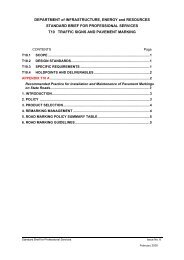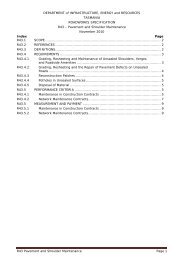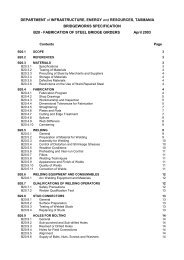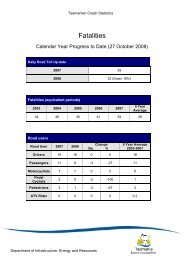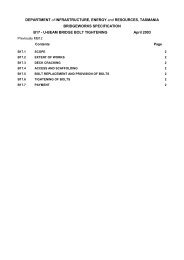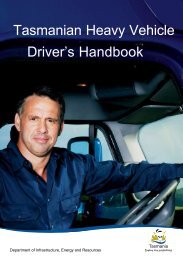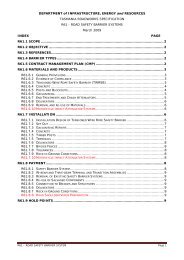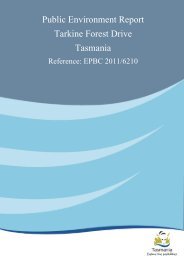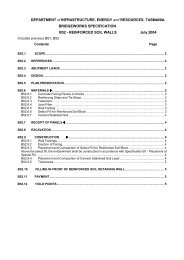Heavy Vehicle Reform Legislation Q and A, (PDF) - Transport
Heavy Vehicle Reform Legislation Q and A, (PDF) - Transport
Heavy Vehicle Reform Legislation Q and A, (PDF) - Transport
You also want an ePaper? Increase the reach of your titles
YUMPU automatically turns print PDFs into web optimized ePapers that Google loves.
QUESTION AND ANSWERSHEAVY VEHICLE NATIONAL LAW(TASMANIA) BILL 20131. WHY ARE WE DOING IT?The Council of Australian Governments (COAG) is driving anational program of micro-economic reforms in a range ofsectors, to produce single regulatory environments for theAustralian economy.At present:• requirements for heavy vehicle operators vary acrossjurisdictions;• some model laws have been partially implemented, or notat all, leading to problems for cross-border compliance <strong>and</strong>enforcement;• operators have to navigate a maze of government bodiesfor registration, vehicle st<strong>and</strong>ards <strong>and</strong> access.The more divergence within the law, the more resourcesinterstate operators must expend on compliance.In August 2011, COAG (with the exception of WesternAustralia), signed the Intergovernmental Agreement on<strong>Heavy</strong> <strong>Vehicle</strong> <strong>Reform</strong> to establish an independent regulator<strong>and</strong> national law for all vehicles over 4.5 tonnes Gross <strong>Vehicle</strong>Mass (GVM). These include trucks, prime movers, buses, <strong>and</strong>large trailers.Under the IGA, the objective is to achieve:• seamless national regulation;• consistent administration;• streamlined provision of services; <strong>and</strong>• lower compliance costs for industry.The Regulator will make it easier for businesses <strong>and</strong> workersto operate across state borders, providing a stable platformfor ongoing change <strong>and</strong> long term improvements in heavyvehicle regulation.2. WHAT IS INDUSTRY’S POSITION ON THEREGULATOR?Industry has indicated that it strongly supports thesereforms – that there should be a single regulator, <strong>and</strong> asingle set of laws applied to the industry nationally. During2013, the Tasmanian Minister for Infrastructure has receivedcorrespondence from stakeholders including the AustralianTrucking Association <strong>and</strong> NatRoad (National Road <strong>Transport</strong>Operators) who strongly back these reforms.Here in Tasmania, we recognise that those who run transportoperations exclusively within Tasmania, <strong>and</strong> who already havegeneral access to the road network, are unlikely to realisemost of the productivity benefits that accrue from thesenationally harmonised laws.The National <strong>Transport</strong> Commission <strong>and</strong> the Regulator havean ongoing dialogue with industry over the reform agenda,with many issues to be addressed as part of the ForwardWork Program (FWP).Industry had also raised concerns that the Regulator will ineffect be another level of bureaucracy on top of existingstate <strong>and</strong> territory regulators. Significant effort has gone intoexplaining the new structures to be put in place to streamlineregulatory decision making.3. WHAT IS THE NATIONAL HEAVYVEHICLE REGULATOR?Based in Queensl<strong>and</strong>, the host jurisdiction for the law, theRegulator will be a single contact point, providing centralisedservices <strong>and</strong> information to heavy vehicle operators acrossthe nation on matters such as access approvals, vehiclest<strong>and</strong>ards, mass <strong>and</strong> loading, fatigue management, <strong>and</strong>compliance <strong>and</strong> enforcement. From around 2015, theRegulator will also take on administration of heavy vehicleregistration.The objective of the Regulator is to improve productivity<strong>and</strong> competitiveness, to reduce the compliance burden forbusiness, <strong>and</strong> to make it easier for businesses <strong>and</strong> workers tooperate across state borders.The Department of Infrastructure, Energy <strong>and</strong> Resources(DIER) will undertake certain functions here in Tasmania,on behalf the Regulator, under a Service Agreement. Anexample is our <strong>Transport</strong> Inspectors, who for the time beingwill undertake the compliance <strong>and</strong> enforcement roles for theRegulator as employees of DIER.4. WHAT IS THE HEAVY VEHICLENATIONAL LAW?The new National Law is based on twelve existing nationalheavy vehicle model laws progressively developed by theNational <strong>Transport</strong> Commission <strong>and</strong> previously approvedby the Australian <strong>Transport</strong> Council (ATC) over the last twodecades.The National Law consolidates model legislation relating to:• heavy vehicle registration• heavy vehicle st<strong>and</strong>ards• heavy vehicle charges• mass <strong>and</strong> loading• oversize <strong>and</strong> over-mass vehicles• restricted access vehicles• higher mass limitsDepartment of Infrastructure,Energy <strong>and</strong> Resources
QUESTION AND ANSWERS• compliance <strong>and</strong> enforcement• heavy vehicle driver fatigue• heavy vehicle speeding compliance• the intelligent access project; <strong>and</strong>• alternative compliance.The National Law will apply to all heavy vehicles over 4.5tonnes, with the exception of heavy vehicle driver licensing,bus operator accreditation, <strong>and</strong> heavy vehicles transportingdangerous goods.The approach approved by the ATC to develop the NationalLaw was for it to be a consolidation of previous model law,<strong>and</strong> not an effort to substantially change existing policypositions.However, for Tasmania, the scope of change is larger than formost other jurisdictions. In December 2009, the TasmanianParliament passed the <strong>Heavy</strong> <strong>Vehicle</strong> Road <strong>Transport</strong> Act2009, which introduced a number of packages of nationalmodel legislation. This legislation was never gazetted, <strong>and</strong> sodid not come into effect, due to the impending transition tothe national regulator. For this reason, the transition to theNational Law is a larger implementation task for Tasmaniathan for most other jurisdictions. Key changes for Tasmaniaare the introduction of new laws concerning Chain ofResponsibility <strong>and</strong> management of fatigue.The only significant new inclusions from previous modellegislation are the provisions necessary to create theRegulator as a separate corporate entity, including humanresourcing, financial controls, <strong>and</strong> governance structures.5. WHEN WILL THE NATIONAL LAW TAKEEFFECT?From January 2013 the Regulator commenced operationwith a limited set of functions, such as administration ofthe National <strong>Heavy</strong> <strong>Vehicle</strong> Accreditation Scheme <strong>and</strong>Performance Based St<strong>and</strong>ards. In May this year, <strong>Transport</strong>Ministers agreed that the National Law should commence on1 September 2013. This is subject to participating jurisdictionshaving enacted the necessary legislation, <strong>and</strong> supportingsystems being in place. I underst<strong>and</strong> that a readinessassessment will be conducted on a national basis in July.The Australian Capital Territory <strong>and</strong> Northern Territory haveindicated they will not have their legislation in place by 1September, however all mainl<strong>and</strong> States except WesternAustralia will have their legislation passed in time for a 1September commencement.6. WHAT WILL THE NEW NATIONALSYSTEM LOOK LIKE?Once the National Law takes effect, Australia will have its first‘one stop-shop’ for heavy vehicle road transport businesswith government. The Regulator will be responsible for thedelivery of a comprehensive range of regulatory services.Customers of the Regulator will be able to:• align their operations with best-practice fatiguemanagement laws;• operate under consistent national regulations for mass,dimension <strong>and</strong> loading;• operate under national st<strong>and</strong>ards for heavy vehicleinspections;• reduce vehicle downtime through interstate recognition ofinspections <strong>and</strong> defect clearances; <strong>and</strong>• expect a nationally consistent approach to penalties <strong>and</strong>roadside enforcement.7. HOW WILL FATIGUE MANAGEMENTCHANGE?The National Law provides for the safe management offatigue for drivers of ‘fatigue-related heavy vehicles’ (seebelow). The key changes for Tasmania include:• extension of fatigue provisions to buses exceeding 12tonnes GVM;• requirements for drivers to keep a National Work Diary incertain circumstances;• adjustments to st<strong>and</strong>ard requirements for work <strong>and</strong> resttimes; <strong>and</strong>• availability of accreditation in alternative complianceschemes known as Basic <strong>and</strong> Advanced Fatigue Management.Another change is the extension of liability for fatigue-relatedoffences to additional parties in the Chain of Responsibility.At a practical level, the greatest change for Tasmanianindustry relates to work <strong>and</strong> rest times under ‘St<strong>and</strong>ardHours’. Under current arrangements in Tasmania, for a 24hour period, you are allowed 12 hours of drive time plus 2hours of non-driving work time.Under St<strong>and</strong>ard Hours under the national law, you will haveonly 12 hours of work time - that includes both driving <strong>and</strong>non-driving work. So while the maximum amount of time youare allowed to drive stays the same at 12 hours, you are losingtwo hours of work time.This brings us into line with the other states that have alreadyhad this in place for some years. The pathway back to 14hours work time is through accreditation under Basic FatigueManagement. This is the big change for Tasmania, <strong>and</strong> one ofthe reasons we sought an additional six months to bring thisin (see below).8. WHAT IS A ‘FATIGUE-REGULATEDHEAVY VEHICLE’?The changes to the fatigue laws only apply to a ‘fatigueregulatedheavy vehicle’. A ‘fatigue-regulated heavy vehicle’has a Gross <strong>Vehicle</strong> Mass (GVM) of more than 12 tonnes,either on its own or in combination. A bus is also a ‘fatigueregulatedheavy vehicle’ if it has a GVM of more than 4.5tonnes, <strong>and</strong> it seats more than 12 adults (including the driver).• apply online for access permits;
QUESTION AND ANSWERS9. WHEN DO THE FATIGUE PROVISIONSCOMMENCE?Chapter 6 of the National Law (changes to fatigue) willcommence in Tasmania six months after the rest of theNational Law.In 2009, the Tasmanian Parliament passed legislationto introduce national model fatigue laws (which nevercommenced due to the impending arrival of the nationalregulator).At that time, industry <strong>and</strong> Parliament were promised therewould be a six month transition period for education <strong>and</strong>training on the new requirements.Industry operators will need to become familiar with the newlaw, adjust operations <strong>and</strong> contracts, <strong>and</strong> elect whether tooperate under st<strong>and</strong>ard hours or become accredited for Basicor Advanced Fatigue Management.Experience from other states strongly suggests a minimumsix month period is needed for transition to the new rules.10. WHAT ARE THE ‘CHAIN OFRESPONSIBILITY’ REFORMS?This is the second major area of reform for Tasmania.Chain of Responsibility provisions will apply to offencesrelating to mass, dimension <strong>and</strong> loading, fatigue <strong>and</strong> speed.Similar provisions were included in the <strong>Heavy</strong> <strong>Vehicle</strong> Road<strong>Transport</strong> Act 2009, previously passed by Parliament.Chain of Responsibility recognises that drivers <strong>and</strong>transport operators are not the only ones in the supplychain responsible for compliance with road safety <strong>and</strong> otherrequirements. The National Law extends liability for breachesof the law to other parties (such as employers, managers,packers, loaders <strong>and</strong> unloaders, consignors <strong>and</strong> consignees,schedulers <strong>and</strong> receivers) if they fail to take reasonable stepsto prevent a breach occurring.Industries can develop <strong>and</strong> register a Code of Practice toeducate members about their responsibilities, <strong>and</strong> ensurecompliance with the law.11. HOW WILL HEAVY VEHICLEREGISTRATION CHANGE?The goal is a single national registration system for heavyvehicles, however this will not commence with the rest of theNational Law. The goal is that if you move a vehicle from onestate to another, you won’t have to de-register <strong>and</strong> re-register.You will be able to register from any location. There will beone national certificate of registration <strong>and</strong> one national plate.There are considerable technical challenges in building anew system <strong>and</strong> migrating the entire heavy vehicle fleet ontoit. For this reason, <strong>Transport</strong> Ministers have agreed to defercommencement of this chapter in the national law until July2015, with a business case to be finalised this year.State-based registration for heavy vehicles will continue untilthe new national system is introduced.12. HOW WILL VEHICLE STANDARDSCHANGE?<strong>Vehicle</strong> st<strong>and</strong>ards are already generally consistent acrossall jurisdictions. However, there are variations in theinspection regimes conducted by Authorised Officers <strong>and</strong>Authorised Inspection Stations. There are also variationsin the qualifications <strong>and</strong> auditing of inspection personnel.The national system will deliver more consistent inspectionprocesses <strong>and</strong> mutual recognition of vehicle inspectionsacross state boundaries.13. HOW WILL PENALTIES CHANGE?Nationally-consistent penalties mean that all drivers,operators <strong>and</strong> participants in the supply chain are subjectto the same penalties regardless of where they operate.In the event of non-compliance, penalties will be appliedthrough a tiered risk management approach consisting ofminor, substantial, severe <strong>and</strong> critical risk categories. This willpromote consistency <strong>and</strong> transparency across the country.The maximum (court imposed) penalties specified for eachoffence in the National Law are the result of an extensiveprocess to harmonise penalties across the country. Thepenalties proposed under the National Law are generallyhigher than current maximum penalties in Tasmania.Under the National Law, penalties are expressed as amonetary amount instead of a ‘penalty unit’, as there is noagreement on a national penalty unit.During May 2012, the National <strong>Transport</strong> Commissionconducted targeted industry consultation on the proposedpenalty classifications <strong>and</strong> penalty levels. In response toindustry feedback, some proposed maximum penaltyamounts have been reduced; <strong>and</strong> jurisdictions agreed to setthe level of infringement (on the spot) penalties at 10% of themaximum (court imposed) penalty.<strong>Transport</strong> Ministers have requested that penalty amountsunder the National Law be reviewed after two years.14. HOW WILL FEES FOR SERVICECHANGE?The Regulator will charge fees for services based on anaverage of the relevant fees currently charged by the states<strong>and</strong> territories. Tasmania has previously not charged feesfor many of its regulatory services for heavy vehicles, so forTasmania there will be new fees in some areas, such as accesspermits <strong>and</strong> accreditation. For example, an operator willbe charged $79 to apply for an access permit; <strong>and</strong> $26 pervehicle for accreditation under certain alternative complianceschemes.15. WHAT ARE ‘LOCAL PRODUCTIVITYINITIATIVES’?Local productivity initiatives (LPIs) are local regulations,instruments, or operational practices that depart fromnational laws to allow a more productive, efficient orsustainable means of carrying out the freight task where localconditions enable this to occur without:
QUESTION AND ANSWERS• compromising local safety or asset protection dem<strong>and</strong>s dueto the reduced level of risk presented by local conditions; or• impacting on the national achievement of improved safetyor regulatory outcomes.State <strong>and</strong> territory road <strong>and</strong> transport authorities currentlyissue LPIs through a variety of methods, including gazettenotices, guidelines, or operational policies (for blanketexemptions for all heavy vehicles of a certain type). Foroversize or overmass vehicles <strong>and</strong> combinations carryinglarge indivisible loads, LPIs are generally provided for under apermit.There are currently hundreds of existing gazette notices,guidelines <strong>and</strong> policy instruments <strong>and</strong> tens of thous<strong>and</strong>s ofpermits issued across Australia.When the National Law is in place across all participatingstates <strong>and</strong> territories, the Regulator will become responsiblefor issuing all new notices <strong>and</strong> permits as well as reviewingexisting LPIs for possible national applicability.Tasmania has implemented a number of local productivityinitiatives to suit Tasmanian conditions, which vary fromproductivity initiatives implemented in other jurisdictions.The National Law will allow for existing local productivityinitiatives to continue, while the Regulator will assess thebenefits of applying local productivity initiatives across otherjurisdictions.Examples of Tasmania-specific LPIs include:• mass <strong>and</strong> dimension exemptions for ‘truck <strong>and</strong> dog’ trailers(>19m <strong>and</strong> >50 tonnes)• mass exemptions for buses (providing approximately 0.5tonne additional mass)• mass <strong>and</strong> dimension exemptions for freight containers (highcube <strong>and</strong> export).
QUESTION AND ANSWERS



